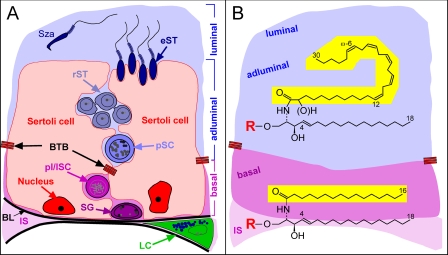FIGURE 1.
A, schematic drawing of spermatogenesis within the seminiferous epithelium. B, testicular sphingolipid structures, the ceramide moiety. A, supporting Sertoli cells (red) adhere to the basal lamina (BL) and develop in addition to the BTB several junctions and specialized contacts to germ cells during all differentiation stages. Spermatogonia (SG) are also adherent to the basal lamina. Spermatogonia type A divide and develop into spermatogonia type B, which enter meiotic prophase and differentiate into primary spermatocytes (SC, preleptotene (plSC) → leptotene (lSC) → zygotene → pachytene (pSC)). Pachytene spermatocytes have traversed the BTB and complete meiosis within the adluminal compartment. Four round haploid spermatids arise from one pachytene spermatocyte and undergo spermiogenesis in 16 steps, including elongated spermatids (eST). Spermatozoa (Sza) are finally released into the lumen. Testosterone producing Leydig cells (LC) are located in the interstitium (IS) between adjacent tubules. B, ceramide moieties of testicular sphingolipids consist of a d18:1-sphingosine base to which a fatty acid is linked through an amide bond. In case of interstitial cells, Sertoli cells and germ cells of the basal compartment of these fatty acid moieties are of long-chain and saturated (mainly palmitic acid), whereas in the case of adluminal germ cells and spermatozoa, they are of very long-chain (C28-32) and polyunsaturated (5-6 double bonds). The sphingolipid head group (R) may be ceramide (H), phosphorylcholine (sphingomyelin), Glc, Lac, Gb3-5, or a complex ganglioside oligosaccharide in case of somatic cells (e.g. Sertoli, Leydig cells) and ceramide, phosphorylcholine, Glc, Lac, and acidic or neutral fucosylated complex ganglio series oligosaccharides in case of germ cells.

